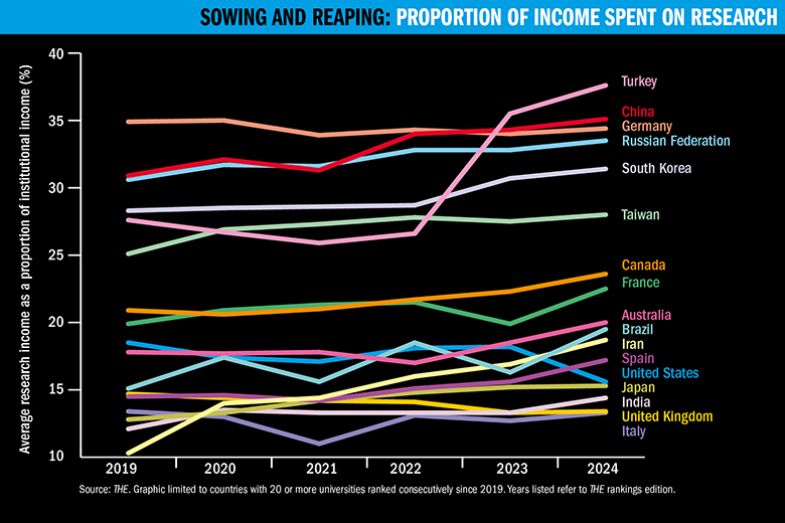Browse the full results of the World University Rankings 2024
The performance of UK and US universities is diminishing as lower shares of institutional budgets are earmarked for research, the latest Times Higher Education World University Rankings data reveal.
The University of Oxford leads the THE World University Rankings 2024 – its eighth consecutive year at the summit – and the rest of the top 10 is filled with Anglo-American institutions. But a longitudinal analysis shows that the overall position of the UK and US is declining relative to other higher education systems.
China is edging closer to the top 10 and now has two institutions in the top 15 for the first time. Tsinghua and Peking universities both overtake the University of Pennsylvania, Johns Hopkins University and Columbia University to rank 12th and 14th respectively in this year’s 20th edition of the ranking. Meanwhile, Japan’s University of Tokyo now outperforms the University of Edinburgh, King’s College London and the London School of Economics and Political Science, after rising 10 places to 29th.
World University Rankings 2024: warning on UK’s China reliance
World University Rankings 2024: Australian elite falters
World University Rankings 2024: a broader look at research quality
World University Rankings 2024: Australia over-achieves in research
World University Rankings 2024: Indonesia top for student-staff ratio
A THE study of six years of data shows that the average rank of US universities has declined from 296 in the 2019 edition to 348 in the latest table; the UK’s average rank has also dropped, to a lesser extent, from 451 to 477.
In contrast, the average rank of universities in China, Australia and Canada has improved – from 635 to 502; 322 to 282; and 349 to 337, respectively.
The analysis only included universities that have been ranked every year since 2019, and countries with at least 10 such universities.
One of the reasons for the waning performance in the US and the UK is falling levels of research funding relative to other countries.

This year, the US overtakes Germany as the country with the highest amount of institutional income per academic. This figure is $1.34 million (£1.08 million) for the average US institution (a rise of 42 per cent since 2019), and $1.33 million for the average German institution (a rise of 23 per cent). The UK’s figure is much smaller at just $439,000 – lower than that of France, Italy, Thailand, Turkey and Canada, among others.
However, in terms of research income per academic – a subset of the institutional income figure – Germany is still top ($457,000), while the US ranks much lower ($208,000) – and is on the decline.
The average share of institutional income dedicated to research has dropped from 18.5 per cent to 15.6 per cent in the US, and 14.7 per cent to 13.4 per cent in the UK, according to the longitudinal study.
In contrast, in several other major higher education systems – including China, South Korea, Canada and Australia – universities’ average proportion of research income has increased since 2019. Germany’s figure has been relatively stable, falling slightly from 34.9 per cent to 34.4 per cent.
Participate in THE's Impact Rankings 2024 - the world's leading impact and sustainability rankings
The US and the UK rank 20th and 25th for proportion of research income, out of 28 countries included in the analysis. Sweden is number one at 65.5 per cent in 2024 (the same share as in 2019), while the Netherlands is second (47.2 per cent) and Turkey is third (37.6 per cent).
While the drop is small, the UK is also the only country included in the analysis that has seen a decline in the absolute amount of research income per academic since 2019 – by 0.3 per cent, to $58,800.
Institutional income is defined as a university’s total income, including general university funds, grant income, contract income, teaching income, donations, investments and commercialisation. Research income is defined as income received “specifically for research purposes” and may be the result of short-term contracts or longer-term research units. The figures are adjusted for purchasing-power parity to make meaningful international comparisons.
The data does not account for the cross-subsidisation of funds; in the UK, for instance, a significant proportion of international student fee income is used for research, but this money would only be counted in the institutional income figure. Billy Wong, THE’s principal data scientist, said it was still striking that “so much of the money in US and UK universities is received outside of research”.
The data raises the question of whether “the growth of the administrative class has become too costly”, he added.
World University Rankings 2024: trends in industry
World University Rankings 2024: UK doubles down on global links
World University Rankings 2024: the shape of rankings to come
World University Rankings 2024 digital edition
There have been increasing complaints of administrative bloat in UK and US higher education, as well as reports of rising sums of money being spent on student experience.
A recent investigation in The Wall Street Journal reports that the US’ “best-known public universities have been on an unfettered spending spree” over the past two decades, investing in new academic buildings, student accommodation and sports programmes and hiring layers of administrators.
Paul Weinstein, senior lecturer in public management at Johns Hopkins University, said that there has been a reduction in US government support for research at the federal and state level but “excessive administrative spending has also crowded out funds that could be better spent on research and teaching”.
“And, of course, the growth in administration – and the resulting processes, rules, and paperwork – has also reduced the amount of time faculty have for research,” he said.
Simon Marginson, professor of higher education at the University of Oxford, said it was “plausible to suggest that the market-focused UK and US are putting a larger share of resources into teaching”.
“On the other hand, research performance is a direct driver of institutional prestige, which delivers market position and helps in attracting students,” he said.
He added that Germany’s top performance for research income per academic reflected the fact that most institutions in the country are research-intensive, unlike in other systems, such as the US. Meanwhile, the declining share of research income in the UK “might reflect the falling away of European funding”, including structural funds.
However, Professor Marginson said it was difficult to be conclusive about comparisons across countries, given the different funding systems and definitions used, while cross-subsidisation was a “complicating factor” in the data.
Baroness Wolf of Dulwich, Sir Roy Griffiths professor of public sector management at King’s College London, said she suspected that the decline in research income shares in the US and UK “represents changes in fee income rather than some major shift in research funding streams”.
“Fees in the US – which has a relatively low proportion of international students – have been rising in real terms. In the UK, we have more and more high-fee international students even though the real value of undergraduate home fees has fallen,” she said.
ellie.bothwell@timeshighereducation.com
World’s top 10 universities overall
|
2024 rank |
2023 rank |
Institution |
Country/region |
|
1 |
1 |
United Kingdom |
|
|
2 |
=3 |
United States |
|
|
3 |
5 |
United States |
|
|
4 |
2 |
United States |
|
|
5 |
=3 |
United Kingdom |
|
|
6 |
7 |
United States |
|
|
7 |
6 |
United States |
|
|
8 |
10 |
United Kingdom |
|
|
9 |
8 |
United States |
|
|
10 |
9 |
United States |
POSTSCRIPT:
Print headline: UK and US lose pace as research funding falls
Register to continue
Why register?
- Registration is free and only takes a moment
- Once registered, you can read 3 articles a month
- Sign up for our newsletter
Subscribe
Or subscribe for unlimited access to:
- Unlimited access to news, views, insights & reviews
- Digital editions
- Digital access to THE’s university and college rankings analysis
Already registered or a current subscriber? Login








